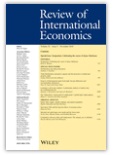Japanese Foreign Investment and the “Land Bubble”
Review of International Economics, 2 (2), 1994, 166-178 https://doi.org/10.1111/j.1467-9396.1994.tb00038.x
Publication year: 1994
Abstract
The aim of this paper is to examine the determinants of Japanese net long‐term capital flows in the 1980s and early 1990s. A basic framework is proposed which takes account of Japan’s so‐called land bubble by incorporating the interaction of land with the banking sector in a macroeconomic portfolio model of capital flows. Empirical evidence is supportive of the hypothesis that land‐related bank loans have been a major determinant of Japanese net long‐term foreign investment. the hypothesis of substitution between direct and indirect foreign investment also receives support, and areas of future research are mentioned.

